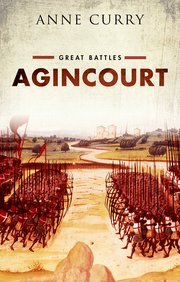
Curry, Anne
Agincourt. Great Battles. Oxford: Oxford University Press, 2015. Pp. 256. $29.95. ISBN: 978-0-19-968101-3.
Reviewed by Steven Muhlberger
Nipissing University (retired)
steve.muhlberger@gmail.com
Anne Curry is a distinguished and prolific scholar of the Hundred Years War. Since 2000 she has written at least three books and ten articles, almost all of them focusing on the battle of Agincourt.
Agincourt, her most recent book-length offering, is part of an Oxford University Press series on "Great Battles." The cover blurb briefly sums up its goal: telling the story of "one of the most iconic battles English history, how it was fought, how it has been remembered, and what it means for us today." This is a reasonably accurate summation of the emphasis of this treatment. There is much more about the historical reception of the battle than there is about the conflict itself.
There are eight chapters, including the introduction and the conclusion. Chapter 2 guides the reader through the events of the battle and the English campaign that preceded and followed it. It is here that Curry offers her own reconstruction of the battle. Chapters 3 through 8 take the reader through various interpretations of the battle, English and French, from the earliest reports to the present. At the same time that Curry discusses the histories, chronicles and archival sources and summarizes the information and interpretations they provide, she shows how these interpretations have originated and how changing priorities have shaped both popular and scholarly understanding of Agincourt and late medieval warfare in general. For instance, historians and chroniclers have long been interested how many warriors fought on either side. Rather than being a subject of military science, studies of the numbers participating more often been scrutinized to gauge the courage or lack of it is those who fought.
Similarly, Agincourt has long been used to make claims about the military virtue of the English or British, or the national characteristics and special talents of regional groups. Some of these claims are unfamiliar: Curry cites a small exhibition mounted by the Public Record Office in 1915 which emphasized key role of Lancashire archers at Agincourt More prominent today is a popular tradition in Wales that connects Welsh bowmen to this famous victory. Curry points out however that this special role of the Welsh is a relatively new story, and seems to be a product of the twentieth century. Both the briefly-praised Lancashire archers and the more prominent Welsh bowmen sprang into prominence during the First World War, and reflect the needs of that time; some of the Welsh still have use for the story.
The well-known legend of the English archers' crucial and devastating role in stopping the advance of the French men at arms during the battle began well before the twentieth century. Curry shows that the image of Agincourt as an archery battle is derived from a variety of sources, some of them late and quite curious. The very early historian of Agincourt, Tito Livio Frulovisi, gives much more prominence to the use of dismounted men at arms by Henry V than he gave to the archers. The nineteenth century saw a great revival of archery as a genteel sport. It is only natural that the connection should be commonly made between the heroic archers of the Hundred Years War (and especially Agincourt) and men and women interested in archery as a heritage sport. The first known British reenactment of the battle, at an Army Pageant of 1910, featured archery and identified Henry's archers as Welshmen. (Whether arrows were actually shot is unclear, but the program emphasized the key role of archery.)
Such events as the Army Pageant had by the twentieth century a great deal of literary, dramatic and graphic material to draw upon in creating reconstructions. Curry devotes two full chapters and parts of others to famous and obscure artistic depictions of the battle. Of course, Shakespeare's
Henry V takes pride of place here, due to its long influence on the historical imagination. There is no doubt that Henry V is England's most famous warrior king, with perhaps the sole exception of Richard I. The victory at Agincourt has absorbed whatever fame that Crécy and Poitiers might have been due. Shakespeare's picture of Agincourt has also been transformed by the ability of cinema to provide visually striking visions of the medieval battle that are easily accessible to the mass audience. Curry documents the lasting influence of the Lawrence Olivier film version of
Henry V, but one wonders if its influence is even now being displaced by Kenneth Branagh's grittier 1989 production.
Chapter 7, "Rival Experts Do Battle over Agincourt," (the title coming from a striking if inaccurate newspaper headline) directs reader's attention to the use of archival sources by modern historians to give a fuller and more detailed picture of Agincourt. This chapter serves to convey the state of the question or questions about the battle and the armies that fought it. Curry is well qualified to discuss this scholarly activity, since she has contributed so substantially to recent debates.
Because Agincourt is Agincourt, the best known medieval battle in the English language tradition after Hastings, there is a lively interchange between popular and scholarly understandings and evaluations. Old questions and old images continue to pop up in the media and even affect the assumptions that scholars work from. It is noteworthy that scholars continue to debate how many warriors fought on either side of the battle. Curry's readers will go away with a keen appreciation of how important historical questions never seem to be finally laid to rest.



0 Comment to "My review of Anne Curry's Agincourt (from the Medieval Review)"
Posting Komentar